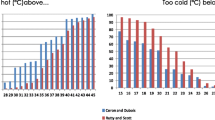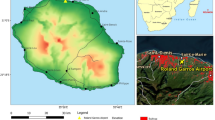Abstract
The complexity of the human-environment interface predicates the need for tools and techniques that can enable the effective translation of weather and climate products into decision-relevant information. Indices are a category of such tools that may be used to simplify multi-faceted climate information for economic and other decision-making. Climate indices for tourism have been popularized in the literature over the past three decades, but despite their prevalence, these indices have a number of limitations, including coarse temporal resolution, subjective rating and weighting schemes, and lack of empirical validation. This paper critically assesses the design of the tourism climate index, the holiday climate index-beach, and a new, mathematically optimized index developed for the unique contextual realities of Great Lakes beach tourism. This new methodology combines the use of expert knowledge, stated visitor preferences, and mathematical optimization to develop an index that assigns daily weather scores based on four weather sub-indices (thermal comfort, wind speed, precipitation, and cloud cover). These daily scores are then averaged to the monthly level and correlated to visitation data at two beach parks in Ontario (Canada). This optimized index demonstrates a strong fit (R2 = 0.734, 0.657) with observed visitation at Pinery Provincial Park and Sandbanks Provincial Park, outperforming both the tourism climate index (R2 = 0.474, 0.018) and the holiday climate index-beach (R2 = 0.668, 0.427). This study advances our understanding of the magnitude and seasonality of weather impact on beach tourist visitation and can inform decision-making of tourism marketers and destination managers.



Similar content being viewed by others
References
Amelung B, Nicholls S, Viner D (2007) Implications of global climate change for tourism flows and seasonality. J Travel Res 45(3):285–296
Anderson BG, Bell ML, Peng RD (2013) Methods to calculate the heat index as an exposure metric in environmental health research. Environ Health Perspect 121(10):1111–1119. https://doi.org/10.1289/ehp.1206273
Barnett J, Lambert S, Fry I (2008) The hazards of indicators: insights from the environmental vulnerability index. Ann Assoc Am Geogr 98(1):102–119
Blazejczyk K, Epstein Y, Jendritzky G, Staiger H, Tinz B (2012) Comparison of UTCI to selected thermal indices. Int J Biometeorol 56(3):515–535. https://doi.org/10.1007/s00484-011-0453-2
Cocolas N, Walters G, Ruhanen L (2016) Behavioural adaptation to climate change among winter alpine tourists: an analysis of tourist motivations and leisure substitutability. J Sustain Tour 24(6):846–865
Damm A, Köberl J, Stegmaier P, Jiménez E, Harjanne A (2019) The market for climate services in the tourism sector – an analysis of Austrian stakeholders ’ perceptions. Clim Serv, (December 2018):1–11. https://doi.org/10.1016/j.cliser.2019.02.001
de Freitas CR (2003) Tourism climatology: evaluating environmental information for decision making and business planning in the recreation and tourism sector. Int J Biometeorol 48(1):45–54
de Freitas CR, Scott D, McBoyle G (2008) A second generation climate index for tourism (CIT): specification and verification. Int J Biometeorol 52(5):399–407. https://doi.org/10.1007/s00484-007-0134-3
Dubois G, Ceron JP, Dubois C, Frias MD, Herrera S (2016) Reliability and usability of tourism climate indices. Earth Perspect 3(1):2
Fisichelli N, Schuurman G, Monahan W, Ziesler P (2015) Protected area tourism in a changing climate: will visitation at US National Parks warm up or overheat? PLoS One 10(6):1?13. https://doi.org/10.1371/journal.pone.0128226
Gomez-Martin MA (2005) Weather, climate and tourism a geographical perspective. Ann Tour Res 32(3):571–591
Gössling S, Scott D, Hall CM, Ceron JP, Dubois G (2012) Consumer behaviour and demand response of tourists to climate change. Ann Tour Res 39(1):36–58
Gössling S, Abegg B, Steiger R (2016) “It was raining all the time!”: ex post tourist weather perceptions. Atmosphere 7(1):10
Hamilton JM, Lau MA (2005) 13 The role of climate information in tourist destination choice decision making. Tourism and global environmental change: Ecological, economic, social and political interrelationships, 229
Hewer MJ, Scott D, Gough WA (2015) Tourism climatology for camping: a case study of two Ontario parks (Canada). Theor Appl Climatol 121(3–4):401–411
Hewer M, Scott D, Fenech A (2016) Seasonal weather sensitivity, temperature thresholds, and climate change impacts for park visitation, 6688(April). https://doi.org/10.1080/14616688.2016.1172662
Hewer MJ, Scott DJ, Gough WA (2018) Differential temperature preferences and thresholds among summer campers in Ontario’s southern provincial parks: a Canadian case study in tourism climatology. Theor Appl Climatol 133(3–4):1163–1173
Jeuring JHG (2017) Weather perceptions, holiday satisfaction and perceived attractiveness of domestic vacationing in The Netherlands. Tour Manag 61:70–81
Jones B, Scott D (2006) Implications of climate change for visitation to Ontario’s provincial parks. Leisure/Loisir 30(1):233–261
Matthews L, Andrey J, Picketts I (2017a) Planning for winter road maintenance in the context of climate change. WCAS 9(3):521–532. https://doi.org/10.1175/WCAS-D-16-0103.1
Matthews L, Andrey J, Hambly D, Minokhin I (2017b) Development of a flexible winter severity index for snow and ice control. J Cold Reg Eng:04017005. https://doi.org/10.1061/(ASCE)CR.1943-5495.0000130
Matthews L, Minokhin I, Andrey J, Perchanok M (2017c) Operational winter severity indices in Canada – from concept to practice, Proceedings of the Transportation Research Board, Standing Committee on Winter Maintenance (AHD65). Paper #17-03338
Mieczkowski Z (1985) The tourism climatic index: a method of evaluating world climates for tourism. Can Geogr/Le Géographe Canadien 29(3):220–233
Missenard A, Balthazard V (1933) Etude physiologique et technique de la ventilation. Libraire De L’Enseignement Technique
Ontario Parks (2018a) Welcome to Ontario parks - the Pinery. Retrieved from https://www.ontarioparks.com/park/pinery. Accessed 3 Dec 2018
Ontario Parks (2018b) Welcome to Ontario parks - Sandbanks. Retrieved from http://www.ontarioparks.com/park/sandbanks. Accessed 3 Dec 2018
Rosselló J, Waqas A (2016) The influence of weather on interest in a “sun, sea, and sand” tourist destination: the case of Majorca. Weather, Climate, and Society 8(2):193–203
Rutty M, Andrey J (2014) Weather forecast use for winter recreation. Weather, Climate, and Society 6(3):293–306
Rutty M, Scott D (2010) Will the Mediterranean become “too hot” for tourism? A reassessment. Tour Hosp Plann Dev 7(3):267–281
Rutty M, Scott D (2013) Differential climate preferences of international beach tourists. Clim Res 57(3):259–269
Rutty M, Scott D (2014) Thermal range of coastal tourism resort microclimates. Tour Geogr 16(3):346–363
Rutty M, Scott D (2015) Bioclimatic comfort and the thermal perceptions and preferences of beach tourists. Int J Biometeorol 59(1):37–45
Rutty M, Scott D (2016) Comparison of climate preferences for domestic and international beach holidays: a case study of Canadian travelers. Atmosphere 7(2):30
Scott D, Lemieux C (2010) Weather and climate information for tourism. Procedia Environ Sci 1(1):146–183. https://doi.org/10.1016/j.proenv.2010.09.011
Scott D, McBoyle G, Schwartzentruber M (2004) Climate change and the distribution of climatic resources for tourism in North America. Clim Res 27(2):105–117
Scott D, Jones B, Konopek J (2007) Implications of climate and environmental change for nature-based tourism in the Canadian Rocky Mountains: a case study of Waterton Lakes National Park. Tour Manag 28(2):570–579
Scott D, Gössling S, de Freitas CR (2008) Preferred climates for tourism: case studies from Canada, New Zealand and Sweden. Clim Res 38(1):61–73
Scott D, Lemieux CJ, Malone L (2011) Climate services to support sustainable tourism and adaptation to climate change. Clim Res 47(1–2):111–122
Scott D, Rutty M, Amelung B, Tang M (2016) An inter-comparison of the holiday climate index (HCI) and the tourism climate index (TCI) in Europe. Atmosphere 7(6):80. https://doi.org/10.3390/atmos7060080
Scott D, Matthews L, Burrowes R, Eyzaguirre J (2019) Consultancy to develop climate products and services for the Caribbean Tourism Industry (feasibility study). Prepared for: the Caribbean Tourism Organization and the Caribbean Development Bank. 71 pp
Soares MB, Dessai S (2015) Exploring the use of seasonal climate forecasts in Europe through expert elicitation. Clim Risk Manag 10:8–16
Soares MB, Alexander M, Dessai S (2018) Sectoral use of climate information in Europe: a synoptic overview. Clim Serv 9:5–20
Steadman R (1979) The assessment of sultriness. Part I: a temperature-humidity index based on human physiology and clothing science. J Appl Meteorol 18(7):861–873
Steiger R, Abegg B, Jänicke L (2016) Rain, rain, go away, come again another day. Weather preferences of summer tourists in mountain environments. Atmosphere 7(5):63
Wilkins E, de Urioste-Stone S, Weiskittel A, Gabe T (2018) Effects of weather conditions on tourism spending: implications for future trends under climate change. J Travel Res 57(8):1042–1053
Yu G, Schwartz Z, Walsh JE (2009) A weather-resolving index for assessing the impact of climate change on tourism related climate resources. Clim Chang 95(3–4):551–573
Acknowledgements
The authors gratefully acknowledge the provision of weather data by Environment and Climate Change Canada and the provision of parks data from the Ontario Ministry of Natural Resources, Parks and Protected Areas.
Author information
Authors and Affiliations
Corresponding author
Rights and permissions
About this article
Cite this article
Matthews, L., Scott, D. & Andrey, J. Development of a data-driven weather index for beach parks tourism. Int J Biometeorol 65, 749–762 (2021). https://doi.org/10.1007/s00484-019-01799-7
Received:
Revised:
Accepted:
Published:
Issue Date:
DOI: https://doi.org/10.1007/s00484-019-01799-7




